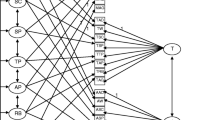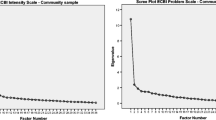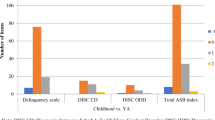Abstract
The Aberrant Behavior Checklist (ABC; Aman, Singh, Stewart, & Field, 1985a, 1985b) is a 58-item third-party informant rating scale originally developed for institutionalized, low-functioning adolescents and adults. The present study investigated the appropriateness of the scale for youngsters with dual diagnosis of mental retardation and psychiatric disturbance. Over a period of 2 1/2 years, 204 patients (199 after data reduction) from a child psychiatry unit were rated twice daily by direct care staff. Data analysis addressed internal consistency, interrater reliability, criterion validity, and robustness of the factor structure. Internal consistency was satisfactory with alpha coefficients ranging from. 82 to .94. Interrater reliability varied between subscales but was relatively low (Pearson correlations between .39 to .61). In terms of its criterion validity, the ABC was sensitive to psychiatric diagnoses and age and the original 5-factor structure was robust (congruence coefficients ranged between .80 to .89). Yet, only a relatively small proportion of the variance (31.5%) was explained by factor analysis indicating possible limitations of the ABC for this population. Given the paucity of assessment instruments for this particular population and the difficulty involved in developing new population-specific instruments, the ABC can be recommended for children and adolescents with dual diagnosis.
Similar content being viewed by others
Reference
Aman, M. G., Richmond, G., Stewart, A. W., Bell, J. C., & Kissel, R. C. (1987). The Aberrant Behavior Checklist: Factor structure and the effects of subject variables in American and New Zealand facilities.American Journal on Mental Deficiency, 91, 570–578.
Aman, M. G., Singh, N. N., Stewart, A. W., & Field, C. J. (1985a). The Aberrant Behavior Checklist: A behavior rating scale for the assessment of treatment effects.American Journal on Mental Deficiency, 89, 485–491.
Aman, M. G., Singh, N. N., Stewart, A. W., & Field, C. J. (1985b). Psychometric characteristics of the Aberrant Behavior Checklist.American Journal on Mental Deficiency, 89, 492–502.
Aman, M. G., Singh, N. N., Stewart, A. W., & Field, C. J. (1985c). The aberrant behavior checklist.Psychopharmacology Bulletin, 21, 845–849.
Aman, M. G., Singh, N. N., & Turbott, S. H. (1987). Reliability of the Aberrant Behavior Checklist and the effect of variations in instructions.American Journal on Mental Deficiency, 92, 237–240.
Aman, M. G., & White, A. J. (1986). Measures of drug change in mental retardation. In K. D. Gadow (Ed.),Advances in learning and behavioral disabilities (Vol. 5, pp. 157–202). Greenwich, CT: JAI.
Campbell, S. B., & Werry, J. S. (1986). Attention deficit disorder (Hyperactivity). In H. C. Quay & J. S. Werry (Eds.),Psychopathological disorders of childhood (pp. 111–155). New York: Wiley.
Cattell, R. B. (1978).The scientific use of factor analysis in behavioral and life sciences. New York: Plenum Press.
Costello, A. (1982). Assessment and diagnosis of psychopathology. In J. L. Matson, & R. Barrett (Eds.),Psychopathology in the mentally retarded (pp. 37–52). New York: Grune & Stratton.
Corbett, J. (1979). Psychiatric morbidity and mental retardation. In F. E. James & R. P. Snaith (Eds.),Psychiatric illness and mental handicap (pp. 11–25). London: Gaskell.
Gilson, S., Levitas, A., & Mead, C. (1987).Psychiatric disorders in community based mentally retarded adults—A statewide survey. Paper presented at the International Research Conference on the Mental Health Aspects of Mental Retardation, Evanston, IL.
Jacobson, J. (1982). Problem behavior and psychiatric impairment within a developmentally disabled population. I: Behavior frequency.Applied Research in Mental Retardation, 3, 121–139.
Kazdin, A. E., Matson, J. L., & Senatore, V. (1983). Assessment of depression in the mentally retarded.American Journal of Psychiatry, 140, 1040–1043.
Matson, J. L., Kazdin, A. E., & Senatore, V. (1984). Psychometric properties of the psychopathology instrument for mentally retarded adults.Applied Research in Mental Retardation, 5, 81–89.
Newton, J. T., & Sturmey, P. (1988). The Aberrant Behavior Checklist: a British replication and extension of its properties.Journal of Mental Deficiency Research, 32, 87–92.
Nihira, K., Price-Williams, D. R., & White, J. F. (1988). Social competence and maladaptive behavior of people with dual diagnosis.Journal of the Multihandicapped Person, 1, 185–199.
Reiss, S. (1988a).The Reiss screen test manual. Orlando Park, IL: International Diagnostic Systems.
Reiss, S. (1988b, September 9).The development of a screening measure for psychopathology in people with mental retardation. Invited paper presented at a joint National Institute of Mental Health—National Institute of Health workshop on the assessment of the mental health aspects of mental retardation, NIMH, Rockville MD.
Rutter, M., Graham, P., & Yule, W. (1970).A neuropsychiatric study of childhood. London: Heinemann.
Senatore, V., Matson, J. L., & Kazdin, A. E. (1985). An inventory to assess psychopathology of mentally retarded adults.American Journal on Mental Deficiency, 89, 459–466.
Strohmer, D. C., & Prout, H. T. (1989).Strohmer-Prout Behavior Rating Scale. Schenectedy, NY: Genium.
Author information
Authors and Affiliations
Additional information
Preparation of this manuscript was supported by grants from the U.S. Office of Human Development Services (grant 07 DD 0270/16) and the Maternal and Child Health Service (Training Project 922) awarded to the Nisonger Center for Mental Retardation and Developmental Disabilities, The Ohio State University. The authors extend their appreciation to Denise Frank and the entire direct care staff of the John Merck Program for their collaboration, to Robert G. Jones for his assistance in data analysis, Sidney S. Sims for computer programming, and Michael G. Aman and Nirbhay N. Singh for critical comments on earlier drafts of the paper.
Rights and permissions
About this article
Cite this article
Rojahn, J., Helsel, W.J. The aberrant behavior checklist with children and adolescents with dual diagnosis. J Autism Dev Disord 21, 17–28 (1991). https://doi.org/10.1007/BF02206994
Issue Date:
DOI: https://doi.org/10.1007/BF02206994




